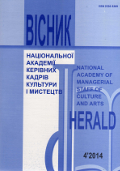ЕСТЕТИЧНЕ ВИХОВАННЯ ТВОРЧОЇ МОЛОДІ: ІСТОРИЧНИЙ АСПЕКТ
The Aesthetic education of the creative young people: the historical aspect
Author(s): Elena KosinovaSubject(s): Anthropology, Cultural history, Aesthetics, Higher Education , History of Education
Published by: Національна академія керівних кадрів культури і мистецтв
Keywords: pedagogical communication; training; extracurricular work; organize educational activities; creative; aesthetic education;
Summary/Abstract: The aesthetic education forms the students understanding of beauty, an aesthetic taste and high aesthetic ideals develop the need to keep beautiful and confirms the desire to make a beautiful life, to form it, as Karl Marx pointed out, "also according to the laws of beauty".The students aesthetic education is a focused and systematic process of aesthetic concepts, tastes and ideals formation, their attitude to the profession of artist, nature and art, to society and life, to communication and relationships, to developing of creative component of professional activity according to the laws of beauty and emotional and sensory responsiveness to the beautiful and ugly…Aesthetic education allows students form the ability to see the highest ideal of beauty in Motherland service, in consolidation for peace and security of nations.The main objectives of students aesthetic education are:* Formation of right understanding of beauty in our life, in studying, literature and art; * Development of pupils’ skills to assimilate beautiful and ugly, softy and base, heroic and unseemly, comic and tragic, harmony, symmetry, proportion, rhythm, measure in reality and art; * Formation of the need of constant communication with beautiful, the intolerance to the ugly in any of its manifestations, development skills to manage their feelings; * Development of students aesthetic tastes, the formation of really worthy aesthetic ideal and the ability to see the beauty of their further work for the prosperity of Motherland; * Improvement the artistic literacy, knowing the national and world cultural heritage, contemporary art; formation needs of artistic self-development; formation needs, skills and abilities aesthetic and artistic creativity; providing methodological and theoretical readiness of graduates to provide aesthetic education for their pupils. The main principles of aesthetics are the base of the development of strategy and tactics of students aesthetic education. Aesthetics reveals the nature of the aesthetic in life and art, learns the basic principles of aesthetic development of the world, explores the aesthetic laws of personality. Different assessments, tastes, views form the aesthetic sense. With the aesthetic ideas and ideals, they are the subjective aspect of aesthetic development of the world and make aesthetic consciousness of personality. It is a subjective reflection of the objective world and at the same time it is a way of essence aspect of real world cognition – its beauty. While revealing the structure and function of aesthetic consciousness, aesthetics determines the formation of aesthetic feelings, evaluations, tastes, ideals. The creation of aesthetic conditions provides pedagogical activity of subjects and objects of education process in terms of aesthetics requirements. Thus, the teaching-material, institutional, moral, psychological, aesthetic and hygienic conditions naturally determines the effectiveness of the aesthetic education of students. So, the process of formation in high school the future specialist with professional, moral, aesthetic, psychological qualities provides through the purposeful work. Aesthetic education is considered as one of the most important trends in the implementation of the tasks of the national higher education.Important role in ensuring the effectiveness of training and students aesthetic education plays a creative use of relevant international experience in processes of creative young people training.Principles of education are leading pedagogical theses and reflect the requirements of laws and regularities of educational process. The most general regularity of aesthetic education is natural pedagogical process dependence on the requirements of modern information society.Training of specialists in arts high school naturally depends on the policy and ideology of the state governing. Aesthetic education in the information society naturally depends on a combination of objective and subjective environmental factors that promote or inhibit the development of personality. Unity and interconnection of education and personal development are the regularities of aesthetic education process. Interconnection of regularities (laws) and principles is difficult. Specific principles may reflect the requirements of one law, some part of law or requirements of the interaction of several laws. Set of principles determines the focus, content, organization and methods of the educational process in high school. Understanding the nature of principles allows consciously and creatively solve problems of education, organize educational activities, reasonably implement it and confidently reach the goal of education.There are some basic principles in the system of students education: feasibility and interconnection with life; education in creativity process, learning and extracurricular work; education in team and through team; individually differentiated approach to pupils; combination of reasonable insistence to student with respect to him; relying on the positive in personality and in team; unity and continuity of pedagogical influences. Principles allow educational activities comprehensively, consistently and skillfully. As the primary pedagogical positions, they regulate the use of tools, methods, techniques and forms of work and serve the objectives of students aesthetic education.Teaching and learning process has significant opportunities for students aesthetic education. Penetrating to the essence of objects, processes and phenomena that are learned, a pupil perceives also the inherent aesthetic qualities. K.Ushynskyy said: "Any science has more or less an aesthetic element, which transferring to students each mentor must have in mind".
Journal: Вісник Національної академії керівних кадрів культури і мистецтв
- Issue Year: 2014
- Issue No: 4
- Page Range: 139-144
- Page Count: 6
- Language: Ukrainian

